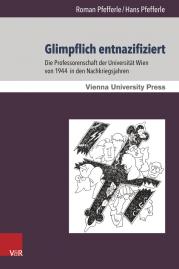 In der hauseigenen Reihe "Schriften des Archivs der Universität Wien" , herausgegeben von Kurt Mühlberger, Thomas Maisel und Johannes Seidl (Vienna University Press bei V&R unipress ), ist der 18. Band erschienen:
In der hauseigenen Reihe "Schriften des Archivs der Universität Wien" , herausgegeben von Kurt Mühlberger, Thomas Maisel und Johannes Seidl (Vienna University Press bei V&R unipress ), ist der 18. Band erschienen:
Die Entnazifizierung und Rehabilitierung der Professorenschaft der Universität Wien nach 1945 war ein komplexer und vielschichtiger Prozess, der mit Kriegsende seinen Anfang nahm und sich bis in die späten 1950er Jahre hinzog. Dieser Band liefert dazu erstmalig eine umfassende, gesamtuniversitäre und auf Primärquellen basierende Bestandsaufnahme. Das übergeordnete Forschungsinteresse war dabei stets die Fragestellung, ob die Entnazifizierungs- und die nachfolgenden Rehabilitierungsprozesse tendenziell zu einer Kontinuität oder zu einem Austausch der wissenschaftlichen Eliten an der Universität geführt haben. Davon aus- und weitergehend wurde einigen Beispielen die wissenschaftliche Tätigkeit von betroffenen Professoren vor und nach 1945 gegenübergestellt.
This book is an important and detailed investigation into the process of denazification of the professoriate of the University of Vienna after 1945. The research is extensive and includes all the relevant archives, memoirs and papers. The empirical approach which has been adopted required meticulous work in the Archive of the University of Vienna, the personal papers of those involved, the documents of the Ministry of Education, memoirs and the Bundesarchiv in Berlin. The authors look in detail at the four Faculties, Philosophy, Medicine, Law, and the two Theological Faculties. The book explains the processes of denazification, compares the experiences of each Faculty and examines the cases of all of those who were implicated, some in great detail, others in short biographies published in the appendix. In addition to the written text, the data is also presented statistically and as graphs. The result is a thoroughly convincing account of the reluctance of the authorities to carry out an extensive denazification programme and the dilemma that they faced in wanting to, on the one hand, appear to cleanse the University of Nazi Elements, and, on the other, to reopen and restore its name. The question of how to accommodate these two contradictory goals is an underlying theme in the book. It is also an underlying theme in the wider history of the foundation of the Second Republic.